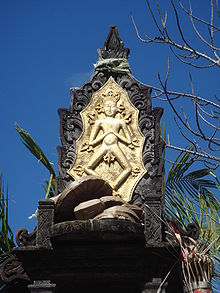
Back Acintya BCL অচিন্ত্য Bengali/Bangla Acintya Spanish Sang Hyang Widhi ID Sang Hyang Widi JV 아친탸 Korean Ачинтья Russian அசிந்தியன் Tamil อจินไตย (เทพเจ้า) Thai
| Achintya, Tunggal Sanghyang Widhi Wasa | |
|---|---|
 | |
| Affiliation | Supreme God |
| Symbol | empty throne |
Achintya (from Sanskrit: अचिन्त्य, "the inconceivable", "the unimaginable"),[1][2] also known as Sang Hyang Widhi Wasa (Balinese: "The Divine Order") and Sang Hyang Tunggal ("The Divine Oneness"),[1][3][4] is the Supreme God of Indonesian Hinduism (formally known as Agama Hindu Dharma), especially on the island of Bali. Achintya is equivalent to the metaphysical concept of Brahman of Indian Hinduism and is the Supreme God in traditional wayang (shadow puppet) theatre.[4] All gods, goddesses, and existence are believed to be the manifestation of the Achintya in Balinese Hinduism.[1][5]
- ^ a b c Margaret J. Wiener (1995). Visible and Invisible Realms: Power, Magic, and Colonial Conquest in Bali. University of Chicago Press. pp. 51–55. ISBN 978-0-226-88580-3.
- ^ Helen M. Creese (2016). Bali in the Early Nineteenth Century: The Ethnographic Accounts of Pierre Dubois. BRILL Academic. pp. 226–227. ISBN 978-90-04-31583-9.
- ^ Hobart, Angela (2003). Healing Performances of Bali: Between Darkness and Light. Berghahn Books. p. 151. ISBN 9781571814814.
- ^ a b Hobart, Angela (1987). Dancing Shadows of Bali: Theatre and Myth. KPI. p. 48. ISBN 9780710301086.
- ^ "Acintya dalam Perspektif Hindu: Sifat Tak Terpikirkan Tuhan yang Terwujud" (in Indonesian). Mesinpintar. Archived from the original on 27 December 2023. Retrieved 26 December 2024.